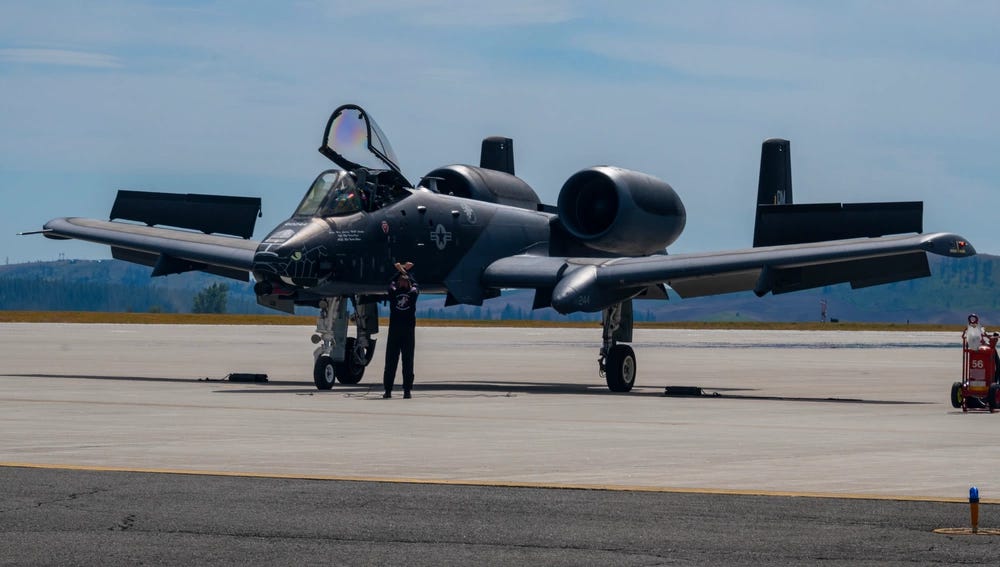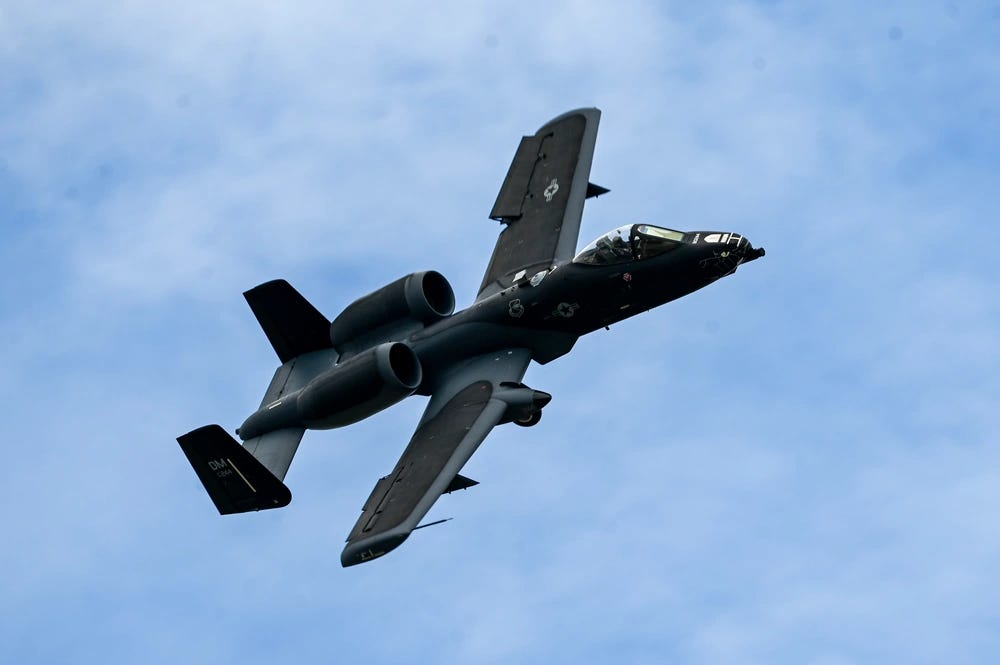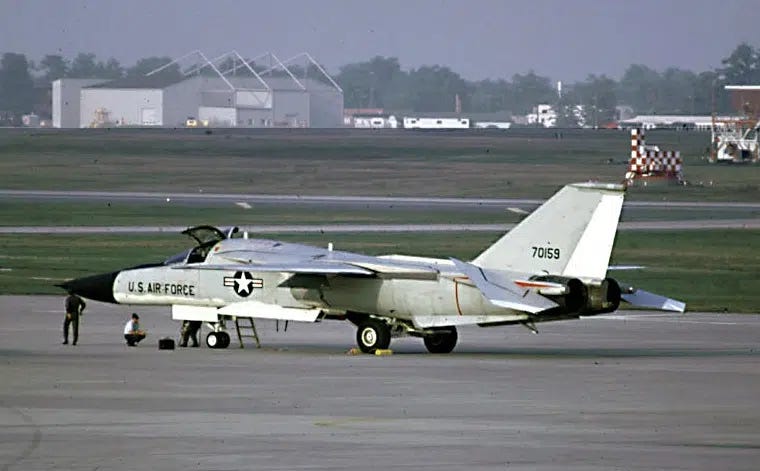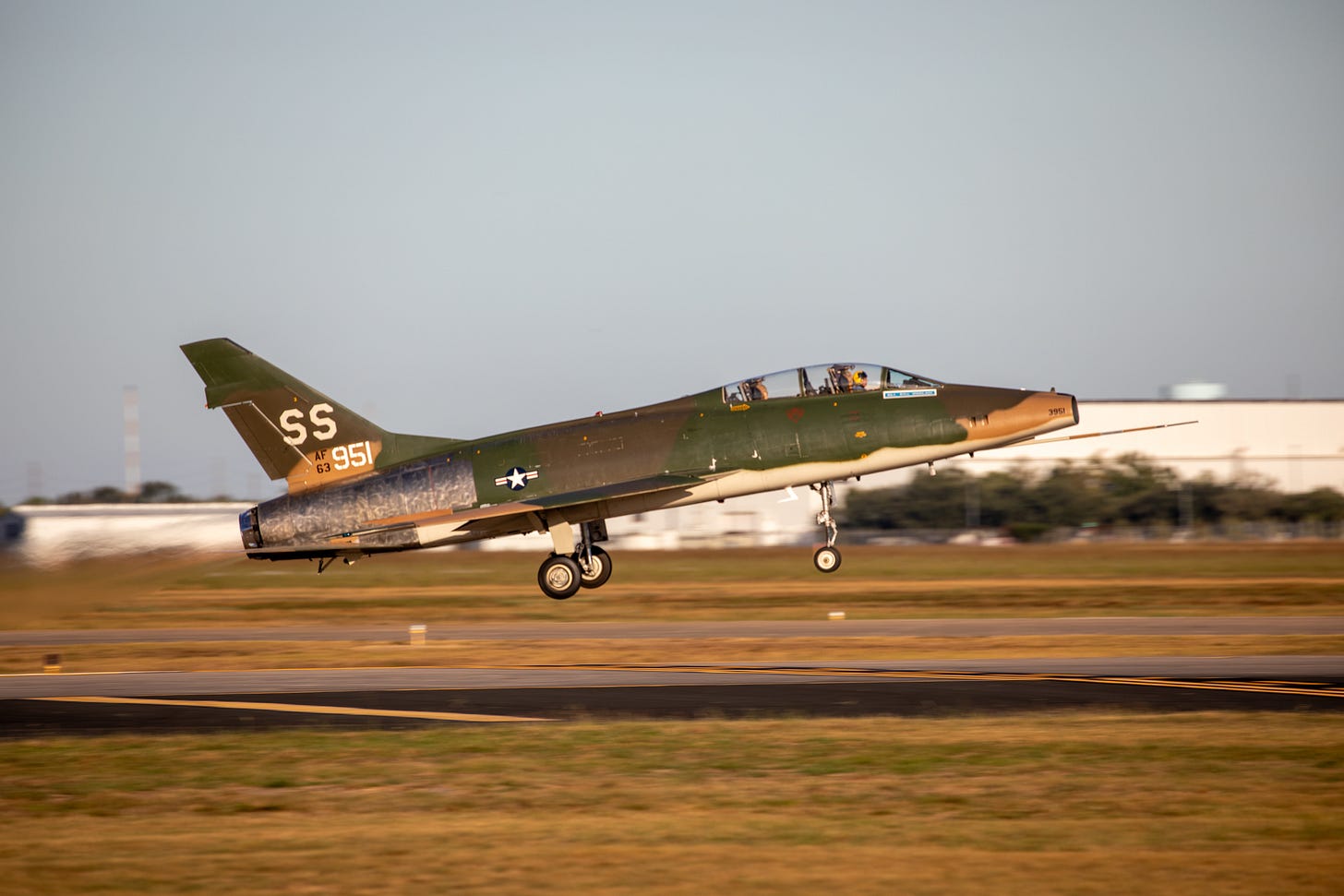Warthog Reprieve and Aardvark Ascent: Old Warriors, New Relevance
As Congress moves to preserve the A-10 and revive key programs cut from the Air Force’s 2026 budget, we look back at the FB-111A Aardvark’s first flight
“There is an art … to flying. The knack lies in learning how to throw yourself at the ground and miss.”
-Douglas Adams
Mission Briefing
So you’re saying there’s a chance???? A couple of issues ago, I wrote about the retirement of the A-10, however now it looks like the Warthog may not be flying off into the sunset - just yet.
Congress is now taking steps to block some of the Pentagon’s most aggressive proposed cuts to the Air Force’s fleet, as outlined in the fiscal 2026 defense budget. That budget, released in June, called for the full retirement of all 162 remaining A-10 Thunderbolt IIs—two years ahead of schedule—along with deep cuts to the F-35A program and a surprising cancellation of the E-7 Wedgetail.
But in a rare bipartisan rebuke, lawmakers are pushing back.
The Senate Armed Services Committee’s draft of the 2026 National Defense Authorization Act (NDAA), approved on Friday, would preserve 103 A-10s through at least 2026, and add 10 more F-35As to the Air Force’s shopping list, raising the total to 35 next year. This move follows a joint letter from 16 retired four-star generals—including six former Air Force chiefs of staff—urging Congress to reverse course on the proposed reductions.
Now, you hear a lot about the A-10 being outdated, or not useful for a “modern” conflict, but there’s something to be said about the longevity and utility of the Warthog. One of the amazing things about the A-10 is that it was purpose-built for one mission: close air support of ground forces. Introduced in the 1970s amid Cold War tensions, the A-10 was designed to fly low and slow over the battlefield, soaking up damage while unleashing devastating firepower on enemy tanks and fortified positions. Its most distinctive feature is the GAU-8/A Avenger (BRRRRRRRRT!) —a massive 30mm rotary cannon capable of shredding armored vehicles with alarming efficiency. Rather than being a typical jet fighter, the A-10 was engineered with survivability in mind: titanium armor encases the cockpit, critical flight systems are redundant, and even if one engine is shot out, the Warthog can often limp home.
The A-10 has proven its worth repeatedly in combat—from the deserts of Iraq to the mountains of Afghanistan. Its ability to loiter over the battlefield for extended periods, maintain visual contact with friendly troops, and deliver highly accurate munitions makes it a ground commander's favorite. While other aircraft can provide close air support, few can do so with the A-10’s mix of precision, durability, and psychological presence. Troops on the ground often say the sound of the Warthog’s gun is the most reassuring thing they can hear during a firefight—an unmistakable BRRRRT that signals help has arrived.
Despite its battlefield record, the A-10 has faced repeated retirement attempts from the Air Force, which seeks to shift focus to stealth and multi-role capabilities for great power competition. Critics argue the Warthog is too vulnerable for modern peer conflicts, but supporters counter that no other platform fills its role as effectively—especially in lower-intensity operations, humanitarian missions, and counterinsurgency warfare. The A-10 isn't just an aircraft; it's a symbol of American airpower doing what it does best—supporting troops and dominating the low-altitude fight. Maybe, just maybe we can get a few more years out of the Warthog. What do you think? Comment below, I’d love to hear your thoughts.
Meanwhile, over in the House, lawmakers are moving to salvage the E-7 Wedgetail program, Boeing’s replacement for the aging E-3 Sentry AWACS fleet. While the Pentagon has tried to cancel the E-7, citing cost overruns and survivability concerns in peer conflicts, the House Armed Services Committee would restore $600 million to keep the program alive, raising the total 2026 budget to nearly $800 million and allowing continued rapid prototyping.
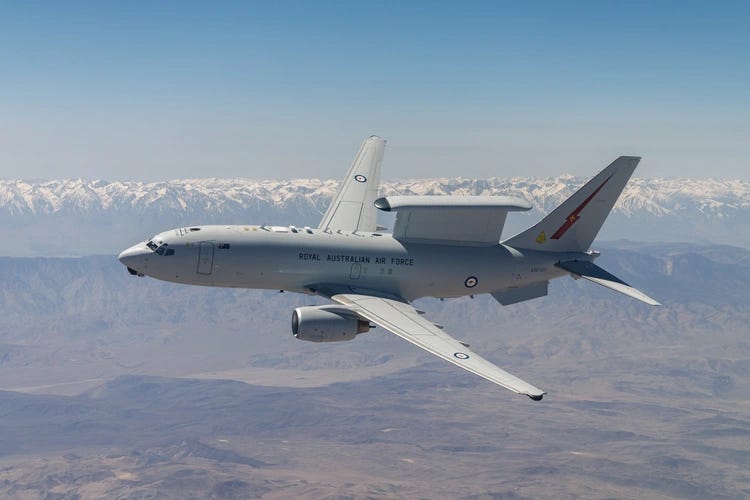
Also making a comeback? The Air Force’s hypersonic ambitions. After a series of failed test flights, the AGM-183A Air-launched Rapid Response Weapon (ARRW) was largely shelved. But the House NDAA would fund the ARRW with $387 million—signaling renewed interest in hypersonic strike capabilities, despite its rocky start.
The Senate version of the NDAA would further require the Air Force to provide comprehensive roadmaps for two critical areas: the future of its bomber force and its intelligence, surveillance, and reconnaissance (ISR) capabilities.
If passed, these changes would mark a significant check on Pentagon planning and show Congress’ intent to retain key platforms and technologies in a time of strategic uncertainty.
One thing’s clear: the fight over the future of the Air Force is far from over—and the Warthog still has some fight left in it.
This Week in Aviation History
13 July 1968: at Carswell Air Force Base in Fort Worth, Texas, the first production General Dynamics FB-111A lifted off on its maiden flight—a 30-minute sortie marking a new chapter in American strategic aviation. Piloted by Val Edward Prahl, with navigator W.E. Denton, the FB-111A was a purpose-built strategic bomber for the U.S. Air Force’s Strategic Air Command. Though visually similar to its tactical sibling, the F-111A, this aircraft came with significant upgrades: a larger wing borrowed from the canceled F-111B program, reinforced landing gear, an enlarged bomb bay, and more powerful engines. The result was a bomber that could deliver nuclear or conventional payloads deep into contested territory—at low altitude and high speed.
Nicknamed the “Aardvark” for its long, drooping nose, the FB-111A offered a unique mix of versatility, speed, and range. With variable-geometry wings that swept between 16 and 72.5 degrees, it could fly fast and low through hostile airspace, hugging terrain to avoid radar detection. Its pair of Pratt & Whitney TF30-P-107 turbofan engines each produced over 20,000 pounds of thrust with afterburner, propelling the aircraft to speeds over Mach 2 at altitude. Designed to carry up to six nuclear bombs or a mix of AGM-69 Short Range Attack Missiles (SRAMs) and conventional munitions, the FB-111A gave SAC a fast, flexible deterrent option in the closing decades of the Cold War.

Though only 76 FB-111As were built, their influence was long-lasting. As the B-1B Lancer came online in the 1980s, remaining FB-111s were converted into F-111Gs and repurposed for tactical roles. Some were transferred to the Royal Australian Air Force, where they served until the mid-2000s. The original aircraft from that first 1968 flight, serial number 67-0159, went on to serve as a testbed for weapons integration and received a striking orange-and-white paint scheme during its time at the Sacramento Air Logistics Center. Today, it lives on as a museum piece at the Aerospace Museum of California—a relic of a bygone era, but one that once represented the cutting edge of American strategic airpower.
In Case You Missed It
The F-15EX (Eagle II) is more important than you think:
Photo Outlet
Every issue of Hangar Flying with Tog gets you a free image that I’ve taken at airshows:
Feel free to use these photos however you like, if you choose to tag me, I am @pilotphotog on all social platforms. Thanks!
Post Flight Debrief
Like what you’re reading? Stay in the loop by signing up below—it’s quick, easy, and always free.
This newsletter will always be free for everyone, but if you want to go further, support the mission, and unlock bonus content, consider becoming a paid subscriber.
Your support keeps this flight crew flying—and I couldn’t do it without you.
– Tog



